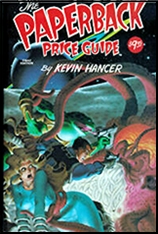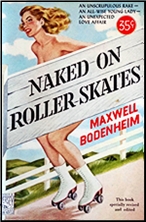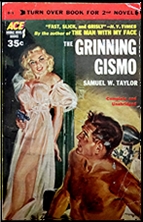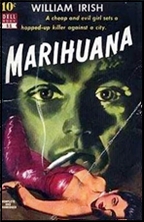Sun 20 Sep 2020
Archived Review: KEVIN HANCER – The Paperback Price Guide.
Posted by Steve under Collecting , Reference works / Biographies , Reviews[8] Comments

KEVIN HANCER – The Paperback Price Guide. Harmony Books / Overstreet Publications, softcover, 1980.
A friend of mine gave me some good advice once. “Never,” he said, “throw anything away before it starts to smell.â€
In this age of compulsive collectibles and instant nostalgia, that’s not such a bad idea. Besides guides for collectors of antiques in general, there are price guides as well for old baseball cards and old comic books, for example, basic commodities of life that have always given mothers such bad reputations (for throwing them away once our backs were turned). There are price guides for old phonograph records, both 45s and 78s, and yes, heaven help us, for beer cans as well, complete with full-color illustrations.

Joining the illustrious company of these and doubtless many others, the hobby of collecting old paperback books has come now into its own. Besides the obvious goal of determination and the compilation of current going prices, using some scheme known only to him – there is little or no relation to any asking prices I have seen, but more about that later – the greatest service that Hancer has given the long-time collector is that he has put together in one spot a more-or-less complete listing, by publisher, of all the mass-market paperbound books that were sold originally in drugstores and supermarkets across the country, for prices that from the first were almost always twenty-five cents each.

By 1960, however, they had crept upward to the thirty-five cent level, or so. (Now , twenty years later again, check the prices of paperbacks in the bookstores today, if you dare.)
Made superfluous are all the various checklists produced by specialist collectors and appearing in mimeographed forms in various short-lived periodicals over the past few years, signall1ng the big boom of interest about to come.
Many early paperbacks were mysteries, and mystery fans have collected them in lieu of the more expensive first editions for some time. An added attraction the cheaper paper editions always had to offer was the cover artwork, designed not-so-subtly to catch the would-be buyer’s eye, but now categorized as GGA. Good Girl Art, that is, a term coined by a comic book dealer, I think.

It speaks volumes for itself, as does the title Naked on Roller Skates, a book by Maxwell Bodenheim which lists for $30. Dell “mapbacks” go high, although most of them still lie in the $5 to $20 range, and so does early science fiction. The first Ace Double goes for $100, however, in mint condition, and a book entitled Marihuana goes for the same amount. The latter was published in 1951, when you could have picked up a copy, had you but known, for ten cents. Last month I could have bought a copy for a mere $13.
Another friend of mine has a theory about scarcity and price guides, and it goes something like this. Whenever the price of something is forced upward by artificial hype, he says, sooner or later it gets so high that no one wants it. If you have it, your only alternative is to find another fool to take it off your hands. The last person who ends up with it and cannot sell it is thereby crowned the Greatest Fool of Them All.
Check out your basements and attics now.
September 20th, 2020 at 10:20 pm
The Price Guides were better at providing indexes and rare glimpses of covers than predicting actual value, which is now and will always be what the market will bear for all but the rarest items.
The Internet hit pulps and comics really hard as so many are available to read or download, and I suspect ebooks are starting to hit paperbacks too with so many available at such reasonable prices or in reprint hard editions still cheaper than collectables you have to leave in a plastic sleeve.
I’ve always been a reader more than a collector so the idea of merely owning something rare just to own it is anathema to me. I’ll take it in any form I can read it, and cover art is all over the Internet and free to download if that is your interest (it’s one of mine).
Back in the eighties I bought two paper bags of comics for $40. I sold them for around $1500. I didn’t get anywhere near Overstreet Price Guide prices, but I made a hefty profit. I could just as easily been stuck with two worthless bags of comics.
There are easier ways to speculate with money that aren’t half as volatile. I think I’ll just buy what I like at the cheapest price I can find. But back in the day the Price Guides were valuable resources I appreaciated, just not for investment purposes.
September 20th, 2020 at 10:40 pm
I remember back in the 1980’s thinking that vintage paperbacks might take off and be worth some real money. But except for some oddball titles and authors, it never happened. Prices flattened out and when the internet and ebay appeared it was obvious that many of these paperbacks were not so rare after all. Many Gold Medals, Dell Mapbacks, and Aces can still be obtained for very inexpensive prices at the conventions. Buying through the mail is more expensive due to shipping costs but still most paperbacks are available for lower prices that we ever predicted back in the 1970’s and 1980’s.
They are still fun to collect but most are not worth much. There are exceptions of course.
September 20th, 2020 at 10:58 pm
David and Walker
You are both right, on all counts. Hancer’s price guide was published 40 years now, a fact that is hard to believe, but it is so, and collecting vintage paperbacks is as dead in the water as it could possibly be. Only dime novels are even less in mind to collectors today.
With exceptions of course. The Internet showed how common most of them are, and ebook reprints did the rest of the damage — and they don’t fall apart when you open them up.
September 20th, 2020 at 11:13 pm
I have complete runs of comics I could never imagine being able to afford at my fingertips for free, and not one of them is foxed, brittle, yellowing, creased, or has to be removed from a plastic bag with white gloves on.
And while I miss my physical library which I lost in 2011, I have replaced a substantial part of it as well as rare books I could never have afforded and have most of it on a couple of backups. In addition I can magnify it for easy reading on multiple devices I can take anywhere.
I still love physical books, it is still my preferred method to read, but where I am now it is a way I can have my books and if it has devalued some of the books I once owned, at least I can still read them.
September 21st, 2020 at 6:40 am
You reminded me how much I missed Pulpfest & Cinevent this year!
September 21st, 2020 at 10:13 am
For one reason or another, I haven’t been to a pulp or paperback convention in the past three years. I was hoping to this year, but obviously things went wacky on us. They’re the only places I know of where you can find hordes of other people who collect the same kind of stuff that you do!
April 4th, 2021 at 2:41 pm
I think the reviewer did not appreciate just how the values in Hancer’s price guide were determined. The values weren’t based on hype or some whim, but were based upon what the books were selling for in the market place, and which books had a demand for them. You have to give the late Mr. Hancer credit, he was a knowledgeable paperback collector and deeply appreciated the history, beauty and enjoyability of vintage paperbacks, he was a fan of their authors, and spotted the cultural significance of their various genres. That knowledge and appreciation informed him as he established his values. I remember there is a section in the price guide where dealers/collectors placed ads and want lists and Mr. Hancer’s want list is right there as well. It is telling that if you look at Hancer’s first price guide, most of the books that he valued the highest and that he featured in the color section of the book are highly sought after today, and have gained dramatically in value. Sure, he missed some things like the dramatic rise in Jim Thompson authored paperbacks, and the demand for mid-60’s sleaze by Clyde Allison, et al, so he didn’t know everything–but he knew most of everything about these vintage paperbacks when he produced his first price paperback price guide.
April 4th, 2021 at 4:05 pm
Hi Nicholas
It sounds as though you knew Kevin fairly well, and if I’ve mischaracterized how he approached putting his price guide together, I apologize. I most certainly was not in a position to know.
But in 1981, when I wrote this review, I had been selling paperbacks by mail for ten years, I think only the second bookseller to specialize that way in selling paperbacks only.
So if I disparaged the numbers that Kevin came up with, I think it was with the knowledge of what they actually sold for, from my own experience, nothing more.
Collecting vintage paperbacks was a fine hobby while it lasted, and Kevin’s book was a great tool to have at the time.
As those who have left comments have suggested, except for a very few key titles, you can find very few takers for almost any of them today, except in the 50 cent or dollar boxes at conventions.